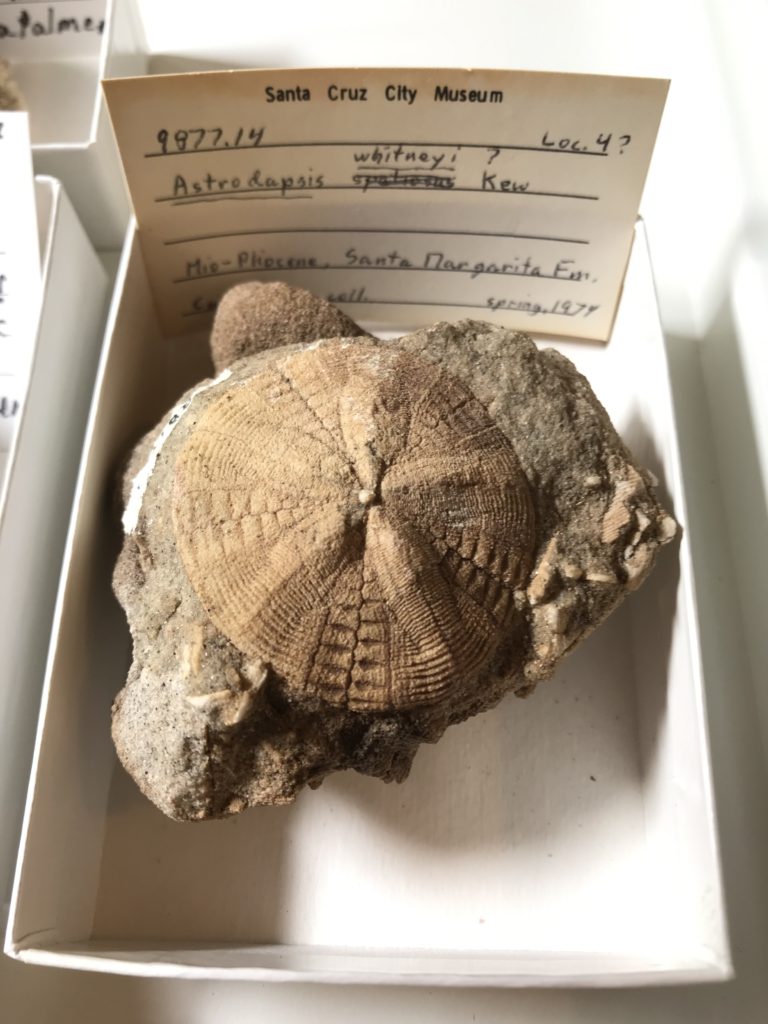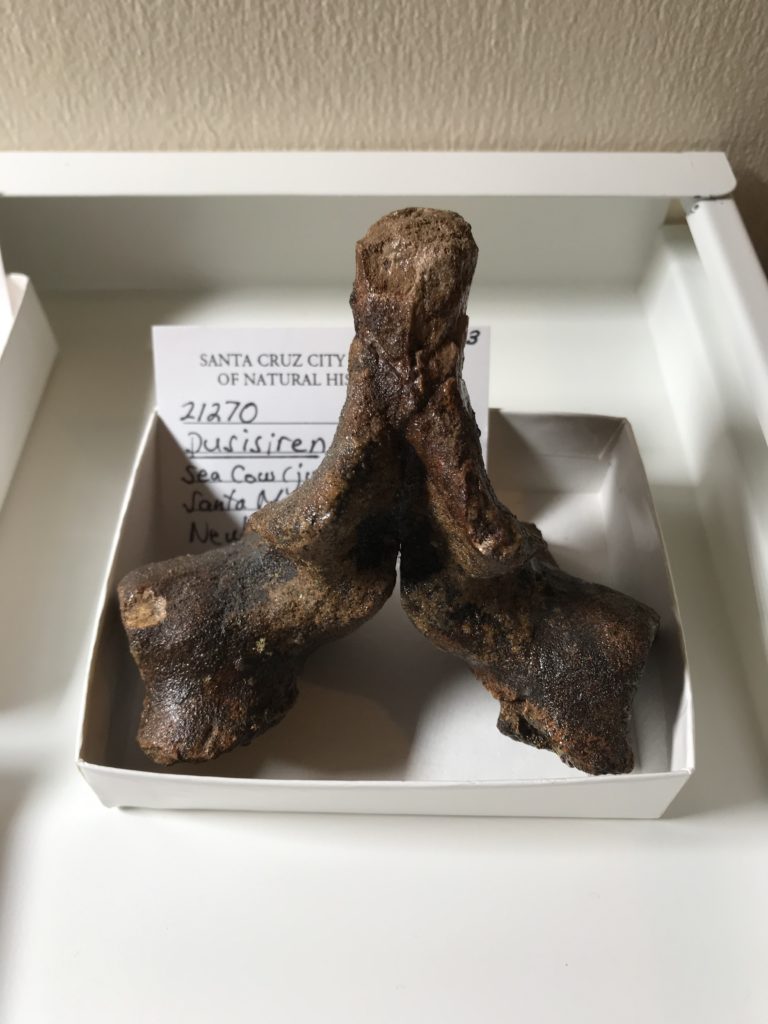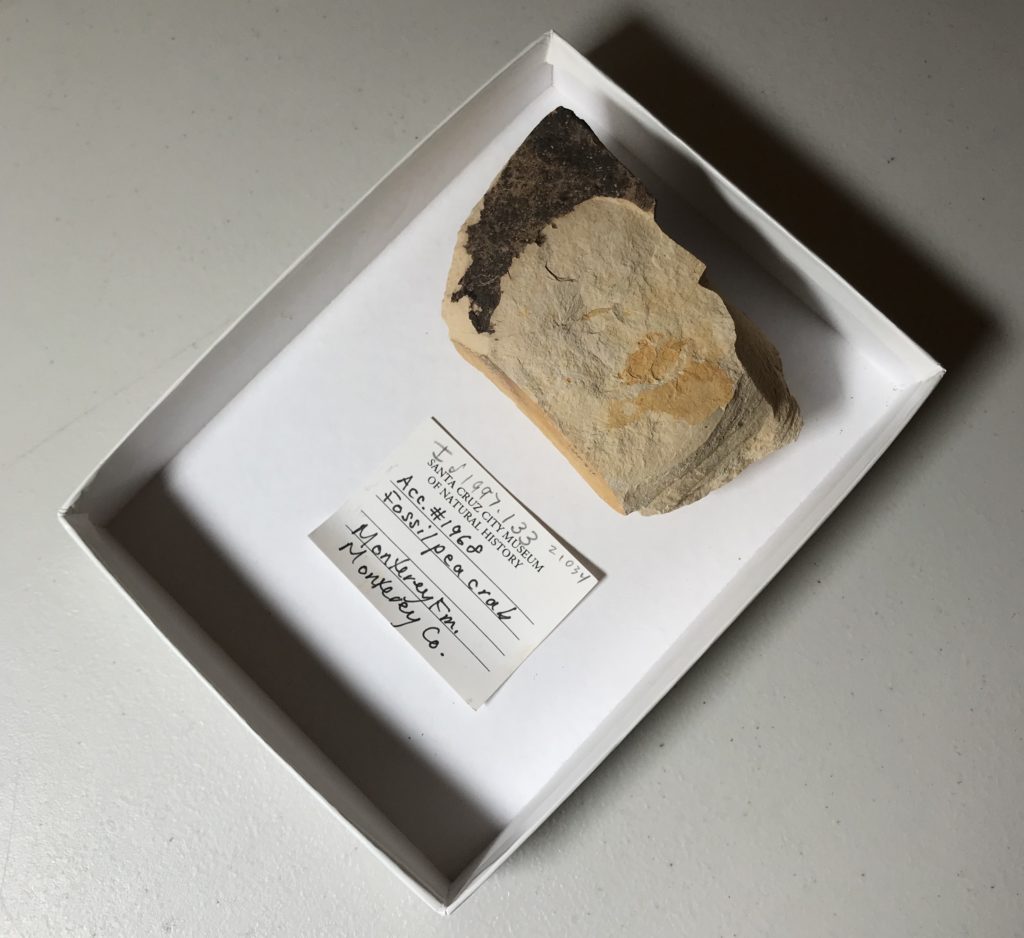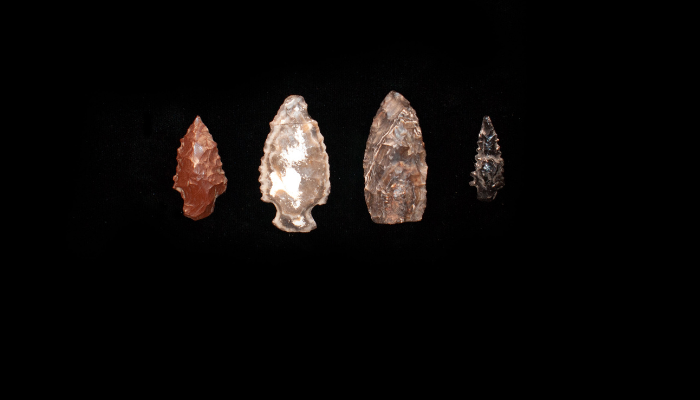Santa Cruz County is home to marvelous wonders, from the shoreline to the summit — and every inch of this landscape was under the ocean mere millions of years ago. In an afternoon you can watch whales breach in the ocean and look at the fossilized remains of their ancestors on the beach (or high up in the mountains for that matter).
From mastodons to megalodons, this guide provides an overview of our local rock formations that feature fossils and how to dig deeper with the resources we’ve compiled.
Jump to: Fossiliferous Formations | FAQ | Additional Resources
Fossiliferous Formations
Before you can understand the fossils of Santa Cruz County, you need to dig a little deeper into the rocks of Santa Cruz County.
Purisima Formation (3-7 Ma)
This sandstone formation was deposited at shallow, near-shore conditions, which is why it has a coarser composition than the Santa Cruz Mudstone it followed. The blue-gray sandstone primarily consists of sediment deposited from rivers dumping into estuaries and bays.

FOSSILS
If you find a fossil on a beach in Santa Cruz County, it is most likely from this formation. The Purisima Formation features dozens of species of invertebrate fossils, especially mollusks, as well as cetaceans and pinnipeds (i.e. whales and seals).
WHERE
Though there are outcrops of this formation north of Santa Cruz, within the County this formation can be found from where Merced Avenue intersects West Cliff Drive in Santa Cruz down to the cliffs of Seacliff State Beach. The best way to find fossils from this formation is at low tide on the beaches below Depot Hill in Capitola, between Capitola Beach and New Brighton Beach. Look to the cliff walls and through boulders and smaller rocks littering the sandy shore.



Santa Cruz Mudstone (7-9 Ma)
While the Purisima Formation formed from shallow-water sediment, the Santa Cruz Mudstone formed farther out at sea where the sediment consists of finer silt and clay. This formation has a more yellow tone and is often patterned with rusty red cracks, caused by methane seeping through the rock while it was still under water.

FOSSILS
Finding a fossil in the Santa Cruz Mudstone formation is a much trickier task than the Purisima Formation that overlays it (in parts), but there are fossils to be found. While most are small bivalves (i.e. clams) and echinoids (i.e. sand dollars), O. megalodon teeth have been found in this Formation.
WHERE
The arch at Natural Bridges State Beach is Santa Cruz Mudstone, as are all of the cliffs up the coast from there until just before Año Nuevo. Read our Guide to the Swift Street Outcrop to learn how to distinguish this mudstone from the Purisima Foundation sandstone.

Santa Margarita Formation (10-12 Ma)
The Santa Margarita Formation is a marine deposit of Miocene sandstone and conglomerate. It is visible in areas of the southern Santa Cruz Mountains and you can spot it by its rough, chunky, and sparkling white appearance.

FOSSILS
Some of Santa Cruz County’s most magnificent fossil finds have been unearthed from the Santa Margarita Formation. According to Frank Perry, “Fossils of at least 20 species of sharks and rays are present, as are remains of bony fishes, marine mammals such as sea cows and sea lions, and invertebrates including mollusks and sand dollars.”
ON EXHIBIT
Features from this formation on display in our exhibits are a cast of a fossil sea cow, an O. megalodon tooth, a jaw bone from a baleen whale, and a dig-box of sand dollars. We also have many more examples in our collections storage, such as the ones seen here.
WHERE
There are outcrops of this formation in the lower parts of the Santa Cruz Mountains all the way up to Año Nuevo, but in Santa Cruz County we find it mostly north of Santa Cruz, through Scotts Valley and up to Boulder Creek. The rare Santa Cruz Sandhills habitat consists of sediment from this formation.



Monterey Formation (17.5-6 Ma)
The Monterey Formation is a Miocene deposit rich in organic material. While it might not reveal fossils of charismatic megafauna like the Santa Margarita formation that followed, the Monterey formation has other interesting biotic features. Monterey Chert, used for tools by Indigenous peoples along the coast for thousands of years, is a feature of the Monterey formation. Chert is extremely diatomaceous (contains high quantities of organic material from plankton), and under other conditions could have become oil. Regularly occurring controversies regarding drilling for oil in the Monterey Bay are due to the presence of the diatom-rich Monterey Formation.

FOSSILS
All of the above notwithstanding, there are micro-fossils to be found. Fossils of diatoms are only visible under a microscope, but fossils of some fish fragments and mollusks are (a little) easier to find. The example from our collections on the left is a fossil pea crab.
WHERE
There are outcrops of this formation throughout the Santa Cruz Mountains — and throughout California. Oil drilling operations off the coast of Southern California and even inland are removing oil from the Monterey Formation. In Santa Cruz County, you can explore this type of rock on parts of Ben Lomond Mountain, along Lompico Creek, and at Majors Creek Canyon.

FAQ
I think I found a dinosaur bone — did I?
That cool thing you found in Santa Cruz is undoubtedly cool, but we gotta tell you — it’s not a dinosaur. Our landscape in Santa Cruz was still millions of years away from forming when the dinosaurs were alive in the Mesozoic era, 248 to 65 million years ago.
So what did I find?
It could be a fossil bone or shell, or it could be a uniquely weathered stone. Explore the resources listed here or email a photo and detailed description to us at info@santacruzmuseum.org. You can help us identify your object if you:
- Include a scale in your images, ideally not something that is relative in size like a hand or a banana, etc.
- Take pictures or videos from multiple angles. For skulls, seeing the teeth is important.
- Provide some general information on where you found it.
May I collect fossils?
Read our extensive guide on collecting ethics. When collecting anything from nature, always practice the “Know Before You Go” philosophy. Determine who manages the land you are on and their laws. For instance, State Parks do not allow collecting of any kind (plants, fossils, etc.), while National Forests do to an extent. Never collect without permission.
Is it a bone or a stone?
There are a few things to consider when determining if the object you have found is a (fossilized) bone or a stone.
- Where was it found? If it was in your lawn, it’s probably a rock. Consider what rock formations are around you and how old they are.
- Look at the texture. A rock will either be made up of packed sediment or crystalized minerals, whereas a fossilized bone will likely show evidence of the canals and webbing featured in actual bone.
Is it a modern bone or is it a fossilized bone?
Discarded bones have canals and webbing within them that are hollow. If the bone has fossilized, this texture will likely still be in evidence, but it will have been “filled” by mineralization. This also means that fossilized bones will likely feel heavier. Depending on how the bone fossilized, it may also have an altered color. BUT dark coloration does no necessarily mean it is a fossil — recent bones can also turn dark just by being under deep sand where the environment is anoxic.
Dig Deeper
Fossils at the Museum
On exhibit at the Museum
- Cast of a fossil sea cow (Dusisiren jordani) excavated from the Santa Margarita Formation at a Zayante sand quarry in 1963.
- Fossil skull of a Pacific Mastodon (Mammut pacificus) discovered in March 1980 by Aptos resident Jim Stanton. He spotted the giant molars protruding from a gravel bank along Aptos Creek.
- Fossil jaw bone of a baleen whale from the Santa Margarita Formation in Scotts Valley.
- An array of shark teeth (including Megalodon), bivalves, plants, and the skulls of a fossil dolphin, walrus, and sea lion, as well as microfossils.
- Garden fossils: Take a stroll around the Museum’s Garden Learning Center and see if you can spot our large whale fossils.
- Activities for kids: Multiple dig boxes features Santa Margarita Formation fossils of sand dollars and casts of a fossil sea cow.
Bring fossils home
- Rent a kit to explore local fossils at home. Kit rentals are $10 per week and can be requested here (you do not need to be a teacher to request a rental).
- Shop the geology and paleontology section of our online store
Explore our other online fossil resources
- Watch: Museum Naturalist Night class on the Santa Cruz Sandhills and their fossils
- Watch: Fossil Walruses and Other Ancient Life in the Monterey Bay with Dr. Robert Boessenecker
- Watch: Collections Close-Up event about our fossil collections and collector Wayne Thompson
- Read: Mastodons and the Museum (about the 2023 mastodon tooth discovery)
- Read: Collections Close-Up blog about our fossil collections
- Read: Collections Close-Up blog about our fossil fur seal skull
- Read: Collections Close-Up blog about our fossil whale ear bone
- Read: Collections Close-Up blog about mammoth and mastodon teeth
- Read: Collections Close-Up blog about paleobotany
- Rockin’ Pop-Up lectures with the Geology Gents
Local Paleontologists: Then & Now
Books and Papers
- Fossil Invertebrates and Geology of the Marine Cliffs at Capitola, California by Frank Perry
- Fossil Sharks and Rays of the Santa Cruz Mountains by Frank Perry
- Cruisin’ the Fossil Coastline: The Travels of an Artist and a Scientist along the Shores of the Prehistoric Pacific by Ray Troll and Kirk Johnson
- Stratigraphy, paleontology, and geology of the central Santa Cruz Mountains, California Coast Ranges by Joseph C. Clark, 1981
Online Resources
- UC Museum of Paleontology
- Mobile Ranger Post on Sandhills
- Mobile Ranger article on the Purisima Formation
- Santa Cruz Mountain Sandhills
- The Paleontological Society
- Frank Perry’s Website
- Upload images of fossils for identification

